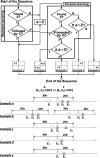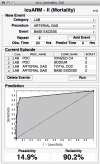icuARM-II: improving the reliability of personalized risk prediction in pediatric intensive care units
- PMID: 27532061
- PMCID: PMC4983419
- DOI: 10.1145/2649387.2649440
icuARM-II: improving the reliability of personalized risk prediction in pediatric intensive care units
Abstract
Clinicians in intensive care units (ICUs) rely on standardized scores as risk prediction models to predict a patient's vulnerability to life-threatening events. Conventional Current scales calculate scores from a fixed set of conditions collected within a specific time window. However, modern monitoring technologies generate complex, temporal, and multimodal patient data that conventional prediction models scales cannot fully utilize. Thus, a more sophisticated model is needed to tailor individual characteristics and incorporate multiple temporal modalities for a personalized risk prediction. Furthermore, most scales models focus on adult patients. To address this needdeficiency, we propose a newly designed ICU risk prediction system, called icuARM-II, using a large-scaled pediatric ICU database from Children's Healthcare of Atlanta. This novel database contains clinical data collected in 5,739 ICU visits from 4,975 patients. We propose a temporal association rule mining framework giving clinicians a potential to perform predict risks prediction based on all available patient conditions without being restricted by a fixed observation window. We also develop a new metric that can rigidly assesses the reliability of all all generated association rules. In addition, the icuARM-II features an interactive user interface. Using the icuARM-II, our results demonstrated showed a use case of short-term mortality prediction using lab testing results, which demonstrated a potential new solution for reliable ICU risk prediction using personalized clinical data in a previously neglected population.
Figures








Similar articles
-
Improving Personalized Clinical Risk Prediction Based on Causality-Based Association Rules.ACM BCB. 2015 Sep;2015:386-392. doi: 10.1145/2808719.2808759. ACM BCB. 2015. PMID: 27532063 Free PMC article.
-
icuARM-An ICU Clinical Decision Support System Using Association Rule Mining.IEEE J Transl Eng Health Med. 2013 Nov 21;1(1):122-31. doi: 10.1109/JTEHM.2013.2290113. eCollection 2013. IEEE J Transl Eng Health Med. 2013. PMID: 27170860 Free PMC article.
-
Domain Adaptation Using Convolutional Autoencoder and Gradient Boosting for Adverse Events Prediction in the Intensive Care Unit.Front Artif Intell. 2022 Apr 11;5:640926. doi: 10.3389/frai.2022.640926. eCollection 2022. Front Artif Intell. 2022. PMID: 35481281 Free PMC article.
-
Survival prediction in intensive-care units based on aggregation of long-term disease history and acute physiology: a retrospective study of the Danish National Patient Registry and electronic patient records.Lancet Digit Health. 2019 Jun;1(2):e78-e89. doi: 10.1016/S2589-7500(19)30024-X. Epub 2019 May 23. Lancet Digit Health. 2019. PMID: 33323232
-
Development and Comparative Analysis of an Early Prediction Model for Acute Kidney Injury within 72-Hours Post-ICU Admission Using Evidence from the MIMIC-III Database.Discov Med. 2023 Aug;35(177):623-631. doi: 10.24976/Discov.Med.202335177.61. Discov Med. 2023. PMID: 37553314
Cited by
-
Improving Personalized Clinical Risk Prediction Based on Causality-Based Association Rules.ACM BCB. 2015 Sep;2015:386-392. doi: 10.1145/2808719.2808759. ACM BCB. 2015. PMID: 27532063 Free PMC article.
References
-
- Miller GA. The magical number seven, plus or minus two: some limits on our capacity for processing information. Psychological review. 1956;63(2):81. - PubMed
-
- Rosenberg AL. Recent innovations in intensive care unit risk-prediction models. Current opinion in critical care. 2002;8(4):321–330. - PubMed
-
- Knaus WA, Draper EA, Wagner DP, Zimmerman JE. APACHE II: a severity of disease classification system. Critical care medicine. 1985;13(10):818–829. - PubMed
-
- Lemeshow S, Teres D, Klar J, Avrunin JS, Gehlbach SH, Rapoport J. Mortality Probability Models (MPM II) based on an international cohort of intensive care unit patients. Jama. 1993;270(20):2478–2486. - PubMed
-
- Le Gall JR, Lemeshow S, Saulnier F. A new simplified acute physiology score (SAPS II) based on a European/North American multicenter study. Jama. 1993;270(24):2957–2963. - PubMed
Grants and funding
LinkOut - more resources
Full Text Sources
Other Literature Sources
Miscellaneous
